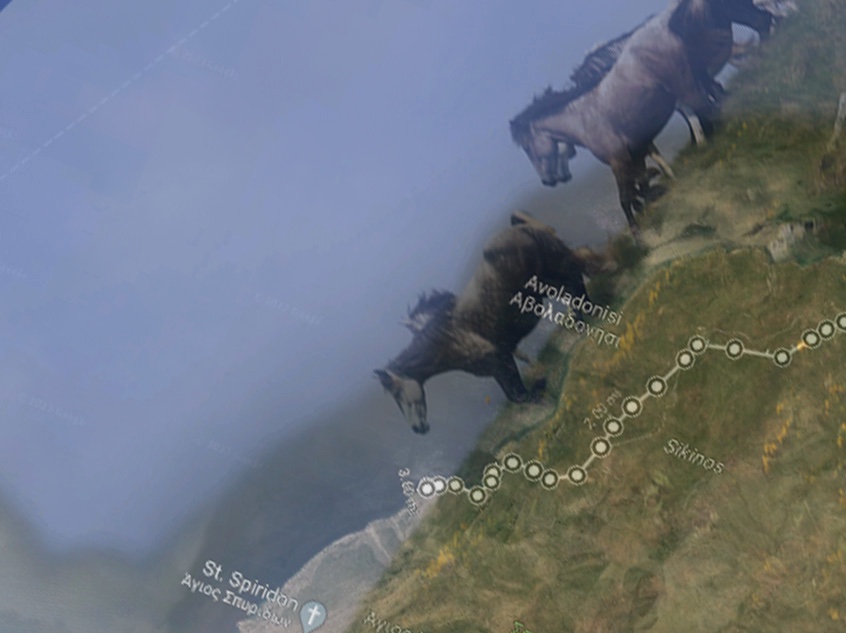With Crossing the Limits Prespa / Grammos / Mytilene / Thermi / Sikinos / Marousi / Athens. The 138 kilometers of Limits, Yannis Ziogas went on a kind of odyssey through Greek landscapes. To experience, and recount.
This walking piece is one of the shortlisted pieces in the Marŝarto Awards 2023. Here, Yannis discusses this work.
Thoughts, initial as they may be, even dead ends…
from the Neiko diaries
In any case, art is not motivated to prove anything.
Just wondering.
Walking is traveling in a quest of transforming the experiences that we encounter into tales and narrating them to others. The experiences can be anything: ideas, incidents, locations, events, persons, objects, reflections, people, names, communities, words. All these, and many more, are transformed into tales, poems, stories, and imprinted memories. In that venture, we can walk alone or be accompanied by those with whom we are sharing the walking quest: the nomadic body. The nomadic body derives and is initiated by the energy of contemplation. When walking the mental (νοερά/noera) process is perpetual.
By walking we travel, we go from one place to another; we create our odysseys. The walking piece Crossing the Limits Prespa / Grammos / Mytilene / Thermi / Sikinos / Marousi / Athens. The 138 kilometers of Limits was unfolded as an odyssey in places, in tales, a sequence of transitions, exploration of the inner and the outer. The nomadic body kept being transformed, various comrades kept walking with me in this ongoing quest for the limits of the unknown, spiritual areas that are not known yet, at least to me. The traversal of contemporary greek landscape in a contemporary walking context is a process of self-exploration between the projections of the others and the identity of who I am. For over four months I walked 138 kilometers in five different sites in Greece to discover the greek landscape in its totality and redefine it. The process created new parameters, initiated innovative processes, captured sensory stimuli, formed concepts, and recalled histories, both individual and collective. It made the place where we live a place/topos again, far from the non-place projections of the European past.
It empowered, all of us who creatively experience the presence of this place in our Being… and thus it created a tale, a Walking Tale in the form of a poem.
This is “A Walking Poem of Curiosities”.
It started North in the high mountains of Macedonia, in the limit of places, it continued East and South in the Aegean Sea and then back to the Big City of Athens. We walked across the blueness and melancholy of Prespa Lake, Miguel, we saw in distance the Mali i Thatë, Christina, we slept under the endless stars of the Universe, Molly, we wanted to discover the hidden tales of the Silent Meadow, Markos, did we? then we found ourselves in the land of Epirus, Jez, the name of the village was Plikati, Nikos, we climbed at the steep mountainside of Grammos, Rena, we bathed in the cold sources of Aliakmon river, Fionna, we crossed crystal clear waters of katharsis, Molly, the scree did not prevent, Sophie, the unexpected willow trees, Karolos, we followed the ridge lines leading to Tsuka Pesik, Christos, from there to the hidden lake of Gistova, where the immobilized waters, Christos, we crossed fertile meadows along with cows, goats, sheeps, dogs, friendly riders, Geert, we entered in abandoned churches with the icons of Saints still existent, Efi, Plikati-Chuka Petsik-Gistova-Grammusta-Fousia were the places we traversed, Alexandra, we found ourselves to the island of Mytilene to the ancient ruins of Therma, Dora, we met with the vicinity of the Sea of the Refugees, Michal, the border of death was accompanying us, washing our feet, Sotiris, the reeds next to the sea, Sophia, the paved road devouring nature, Despina, the bodies trying to find a parallel way, Anna, disembarked in the Island of Sikinos searching for Episkopi, Eleftheria, the forgotten woman, Neiko, she was there and welcomed us, shared the goods and beauty of her existence, Socrates, Neiko proved not to be a woman but a concept, Yorgos, one of the two fighting forces of Nature, deriving from the ancient times and the thoughts of Empedocles, the Full Moon of August, the Blue Moon was there shining over the deep dark waters of the night sea, Tracey, we sailed in the Aegean sea, Dimitris, we passed by the islands of Folegandros, Polyaigo, Kimolos, Milos, Sifnos, Serifos, Kythnos names of islands, names of places, names of topos, Ioanna, till we saw Sounion, Piraeus and we ended up in the Big City, Athens, Yorgos, in the midst of cars, busses, the grey highways, still searching for the unknown, away and the same time close with the other places, Polyneices, there we saw the Beautiful Church in Galatsi, the national flags flying over the main street, and Thenia with her bike coming towards us.
Are there other places?
Or the place is only one?
Where are we?
Where are we walking to?
Where are our realities?
Do they exist?
Where are our comrades of ideas and concepts?
Are they still there?
The winners and honourable mentions of the Marŝarto Awards 2023 will be announced in February 2024.


